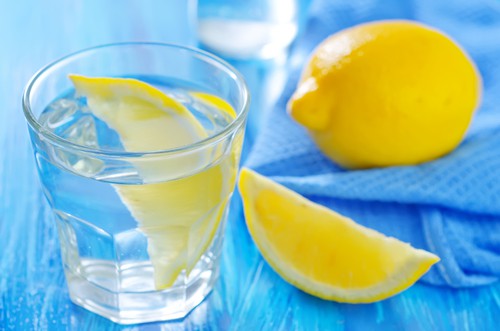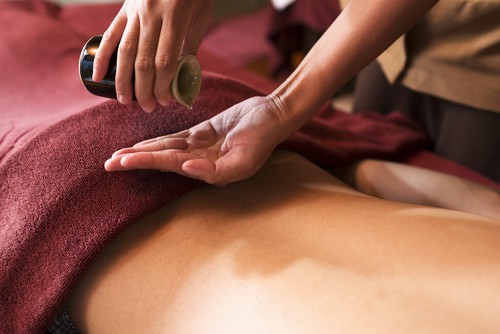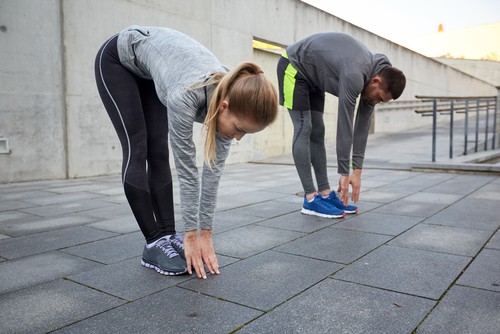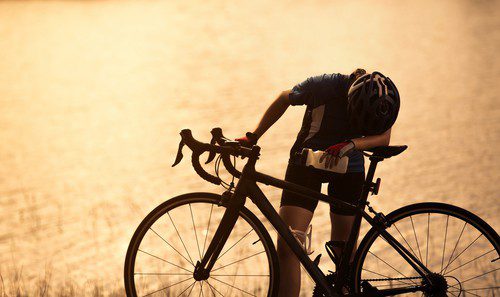Cycling can be an extremely rigorous sport. It can be incredibly tiring after a slew of intense workouts or cycling in a race. However, there are plenty of ways to recover after a tough session.
Here are some practical tips to recovering faster from cycling:
- Drink a lot of water or sports drinks to rehydrate yourself
- Cool down after any session or rac
- Keep moving to avoid muscle tension
- Rest and sleep for 8 hours
- Get a massage or massage yourself
- Wear compression clothing
- Elevate your legs
- Perform some active recovery
- Eat plenty of carbs and proteins
- Do some stretches to cool down the body
- Take supplements
- Take a hot or cold shower, depending on what you need
- Rest your mind with yoga and meditation
- Take care of your mental health
The rest of this article will go in-depth into why recovery is essential and tips for a more speedy recovery.
Why Recovery After Cycling Is So Important
Cycling is a sport that requires energy and a lot of commitment. If you cycle too much without allowing your body to rest, you risk attaining many injuries and even endanger your mental well-being.
Whenever you cycle, you can damage muscle tissue, temporarily weaken your immune system, and you are also pushing your heart and lungs to keep your heart rate going as you move vigorously. Additionally, cycling causes you to sweat, which depletes electrolytes.
Recovering after a session will help you regain your muscle strength and ensure they don’t cramp.
Skipping out on recovery can cause injuries such as:
- Back pain
- Knee pain
- Wrist, arm, and hand pain
- Neck pain
- Hotfoot and other foot pain
- Saddle sores
Skipping recovery can also affect you mentally. Intense cycling can become very stressful and cause irritability, sleeping problems, depression, and even anxiety.
Recovering from intense cycling is crucial to your overall physical and mental health. Unless you do it, there could be some dire consequences.
If you want to avoid paying for medical bills and risking your overall wellness, start getting into the habit of recovering after a cycling session.
It will save you a lot of pain, money, time, and worry.
How To Speed Up Recovery After Cycling
Now that you understand why recovery is essential, you’ll want to learn more about how you can recover after cycling. Chances are, you probably are wondering how you can recover as quickly (and as effectively) as possible.
The length of time that you’ll need to recover mainly depends on your age and experience level in cycling. If you are older, it may take longer to recover than if you were younger. Know yourself and your body, and figure out the time it will take for you to recover.
Making a speedy recovery is possible, but don’t rush your process. Apply as many of these tips as you can, and remember to give yourself time to do it all.
This section will elaborate on 14 practical tips that you can use to recover from cycling as quickly as possible.
1. Drink a Lot of Water or Sports Drinks To Rehydrate Yourself
One of the most important things to do after an intense cycling race or session is to rehydrate yourself. This tip is very common, and you might have already heard about it. However, rehydrating yourself is key to a smooth recovery.

Be sure you drink plenty of water or a sports drink after cycling. Water will keep you hydrated and is fantastic at recovering your body after a lot of muscle work and stress on the body. A sports drink is also a viable option as you lose many electrolytes and carbohydrates in your body, and sports drinks contain all of these necessary elements. Note: Add lemon juice (preferably fresh) to your beverage for much needed electrolytes.
2. Cool Down After Any Session or Race
While you’re taking a drink of cold water or a sports drink, make sure you continue to cycle slowly. To cycle slowly after a session or race is known as cooling down.
Cooling down after cycling is vital for your body to avoid injuries and to avoid the accumulation of lactic acid to one part of the body. It also regulates the heart into a rest rate which helps avoid the feeling of light-headedness.
Regardless of whether you were doing a regular session or participating in a big race, cooling down is a crucial step to take to avoid injuries or even passing out.
3. Keep Moving To Avoid Muscle Tension
In addition to cooling down after cycling, you also want to keep your body moving in general.
Keeping your body moving after cycling prevents your muscles from tightening. Tight muscles cause muscle pain throughout your body, preventing you from wanting to continue cycling, and can even cause injuries when you decide to get back on your bike.
After cooling down, be sure to keep moving around. Try strolling or moving outside or inside your home. The more you move, the less tight your muscles will be.
However, keep in mind that you should be making slow movements. Fast or aggressive actions can tighten your muscles and make you even more sore.
Take it easy and focus on slow and soft motions.
4. Rest and Sleep for 8 Hours
You’ve likely already heard that you need 8 hours of sleep at night. This idea is especially true for athletes and people who regularly put a lot of stress on their bodies.
It would be best if you had plenty of rest throughout your recovery process. Your body must cease activity at the end of the day and regain strength and energy.
For night, be sure that you have had plenty of water and have taken a shower before bed to make your body ready for sleep. Skip the TV for now and try to go to bed early.
5. Get a Massage or Massage Yourself
If you enjoy relaxing and getting a massage, you will love this tip.
Massages can help ease any muscle tension you have after a session or race.

After cycling, give yourself a nice massage. Remember to massage your face, back, arms, legs, and even feet. Have a friend or partner give you a massage.
You can buy an electric or manual massager as well. Here is an excellent electric massager to be used on specific muscle groups on Amazon. There are many options of electric or manual massagers. I have a whole body massage pad with heat that I lie on for my back and neck. I get neck and back pain once or twice a year and need to pull the massage pad out.
However, if you are looking to treat yourself for working hard – it is acceptable for you to want to visit a massage parlor.
6. Wear Compression Clothing
Another foolproof method to recovering after cycling is wearing compression clothes that reduce swelling, pain and fatigue.
A popular compression wear item that athletes wear is compression socks.
Especially in cycling, you use your feet and legs throughout a session or race. Ensure that you wear compression socks and other compression wear to keep yourself from getting sore muscles.
Cycling can cause foot pain and sore legs, so wearing compression clothes is of the utmost importance. Another popular compression item are long leg compression sleeves.
You buy compression clothes online or at your local sporting goods store.
7. Elevate Your Legs
Furthermore, besides compression socks, you also want to elevate your legs.
Because you use so much leg muscle, cycling can make your legs prone to swelling and knee pain.
Elevating your legs causes your leg to drain fluids and stretch your hamstrings. Additionally, elevating your legs can help your blood flow to return to your upper body.
It would help you to elevate your legs and keep them elevated for 5 minutes for each hour of cycling. Doing this will ensure that you spent enough time recovering your legs for all the time you’ve already spent cycling.
8. Perform Some Active Recovery
Though most of your recovery will consist of easy and smooth activities, being active can still work out in your favor.
Recovery does not have to be completely resting or being still. Active recovery demands a lot of movement but is not as intense as cycling or exercising.
Active recovery is another suitable method for stretching your muscles and keeping them from being tense.
Some examples of active recovery can be walking to work instead of driving, taking the stairs instead of an elevator, playing with your pets or children, or deciding to park further from the store or mall.
9. Eat Plenty of Carbs and Proteins
Another way to recover is to eat the proper diet for healing and to rebuild your stamina.

Two food groups that are essential for this are carbs and proteins. Carbs mainly help you build stamina, while proteins are vital for those who want to recover quickly after cycling.
The following are some examples of carbs and proteins:
- Fruits (especially bananas)
- Grains
- Vegetables
- Dairy (mainly milk)
- Meats (turkey and chicken are perfect)
- Eggs
- Seafood (especially Salmon and Tilapia)
Be sure to consume these and avoid heavy “junk” food like candy, cake, sugary cookies, juice, and fast food meats.
10. Do Some Stretches To Cool Down the Body
Another critical step to cooling down the body is to do stretches to relax your muscles.
Stretches are a vital way to recover after an intense cycling session. Stetches keep your muscles from tightening and can loosen up any tension in your body.

Foam rollers are an excellent aid for stretching. Many athletes like to use foam rollers when stretching to help them ease their muscle tension.
Stretching can be an excellent way to get rid of aches slowly, and they will have you recovering in no time.
11. Take Supplements
Vitamins can also help to speed up the post-cycling recovery process.
Take supplements after cycling, preferably, during your meal to speed through your recovery.
Vitamin C is an excellent way to boost your immune system since cycling can temporarily weaken it. Antioxidants are also helpful in fixing your damaged muscle fibers as well.
It is best for you to always have vitamins on hand if you cycle regularly. Vitamins help you to stay healthy and are excellent for rebuilding your stamina and recovering quickly.
12. Take a Hot or Cold Shower, Depending on What You Need
You might be surprised to know that showers are an excellent source for recovery as well. They are relaxing but can also prevent soreness and ease tension.
Hot showers are great at easing tension and can help you feel energized and relaxed. The steam of the shower also is a good aid for falling asleep.
Cold baths are great for relieving and preventing any soreness. The cold water can help your blood flow and avoid swelling as well.
If you are looking for a way to wind down after a busy day of cycling, consider taking a shower. Whether you’re looking for a hot shower to relieve tension or a cold one to prevent soreness, either one can speed up your recovery.
13. Rest Your Mind With Yoga and Meditation
If you want to recover both mind and body, try yoga and meditation.
Yoga involves a lot of stretching and meditation. Stretching, along with mediation, can be a great way to keep your mental health improved after a workout.

There are plenty of videos and guided meditations throughout YouTube, or you can download apps that offer guided meditations.
Consider yoga and meditation for a better recovery process.
14. Take Care of Your Mental Health
In addition to yoga and meditation, you can also try standard mental health practices to improve your mental health throughout your recovery.
You can try the following list below to improve your mental health throughout your recovery:
- Write in a journal: Writing in a journal about how you feel or writing something creative is a great way to relieve stress. It can also help you be more aware of your thoughts and feelings throughout the recovery process.
- Listen to upbeat and lively music: Listening to music that you enjoy and that is upbeat can help you relieve your stress and take off all the tension from your session.
- Talking to friends or family: Talking to friends or family after a tough session can also benefit your recovery and mental well-being.
- Create a piece of art: Art is also a fantastic way to increase your mental well-being. Creating any art can relieve you of stress and tension from your mind and body.
- Take a self-care day: If you find that cycling is stressful and want a smooth (but quick) recovery process, consider taking a self-care day. Self-care days involve doing things to focus on yourself and to take care of your well-being.
- Try and practice gratitude: Practicing gratitude can also be a way to take care of yourself throughout your recovery. It is advisable to keep a gratitude journal to keep track of what you are grateful for and remind yourself of positive aspects of your life.
Keeping your physical wellness fit is essential, but so is your mental wellness. When it comes to recovery, taking care of your mental health will help you focus on moving forward and motivating you to keep doing what you love – cycling.
Conclusion
Making a swift recovery after a tough cycling session or race is possible.
To recover faster after cycling, you need to keep yourself active, maintaining a healthy diet, caring for yourself and your body, practicing good mental health care, and keeping yourself fit.
It takes a lot of time and dedication to succeed in cycling, but rest and recovery are vital to continue your success.
Other related articles you might enjoy:
How Many Rest Days Should a Cyclist Take?
11 Tips for Overcoming Cycling Fatigue

